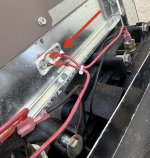I am replacing all of the old pool equipment at my new house with Hayward equipment. I have tried to install a brand new Hayward heater model W3H250FDP that keeps throwing a LO code. I have checked everything I know to check based on searches on this site and the Hayward diagnostic manual, and I wanted to see if anyone here had any ideas before I call in a pro.
What I know:
1. The heater is brand new
2. I have installed a water flow meter and it reads 90 GPM just before the heater inlet (which is well above the minimum flow rate for the heater)
3. I have connected a multimeter to each of the limit switches and have verified with certainty that it is the exhaust gas limit switch (at least, what I THINK is the gas limit switch: it is the white switch above the inlets pictured below is causing the fault).
4. I have opened up the heater inlet union valves and have looked for any debris that might be blocking water flow to the heat exchanger, and found nothing visible.
The heater runs for about 2 1/2 minutes when cold before the switch trips. I tried to remove the internal bypass service cartridge but could not. Either I don't have the strength to pull it out, or there is some release lever that I am unaware of. I looked inside the outlet valve and did not see anything like a broken part.
I do seem to have a small suction side leak that I can't locate. Little bubbles form in my pump basket after a bit. I bled all the air out of the filter before I tried to engage the pump, but I suppose small air bubbles could be trapped inside the exchanger and its boiling?
Is there any way to test the gas temperature limit switch to see if it is defective? Maybe shoot some area of the heat exchanger with an infra red temperature gun and see if it is REALLY too hot? I am doubting it is a defective switch because the unit is new, but I guess it's always possible.
Any ideas?
What I know:
1. The heater is brand new
2. I have installed a water flow meter and it reads 90 GPM just before the heater inlet (which is well above the minimum flow rate for the heater)
3. I have connected a multimeter to each of the limit switches and have verified with certainty that it is the exhaust gas limit switch (at least, what I THINK is the gas limit switch: it is the white switch above the inlets pictured below is causing the fault).
4. I have opened up the heater inlet union valves and have looked for any debris that might be blocking water flow to the heat exchanger, and found nothing visible.
The heater runs for about 2 1/2 minutes when cold before the switch trips. I tried to remove the internal bypass service cartridge but could not. Either I don't have the strength to pull it out, or there is some release lever that I am unaware of. I looked inside the outlet valve and did not see anything like a broken part.
I do seem to have a small suction side leak that I can't locate. Little bubbles form in my pump basket after a bit. I bled all the air out of the filter before I tried to engage the pump, but I suppose small air bubbles could be trapped inside the exchanger and its boiling?
Is there any way to test the gas temperature limit switch to see if it is defective? Maybe shoot some area of the heat exchanger with an infra red temperature gun and see if it is REALLY too hot? I am doubting it is a defective switch because the unit is new, but I guess it's always possible.
Any ideas?


